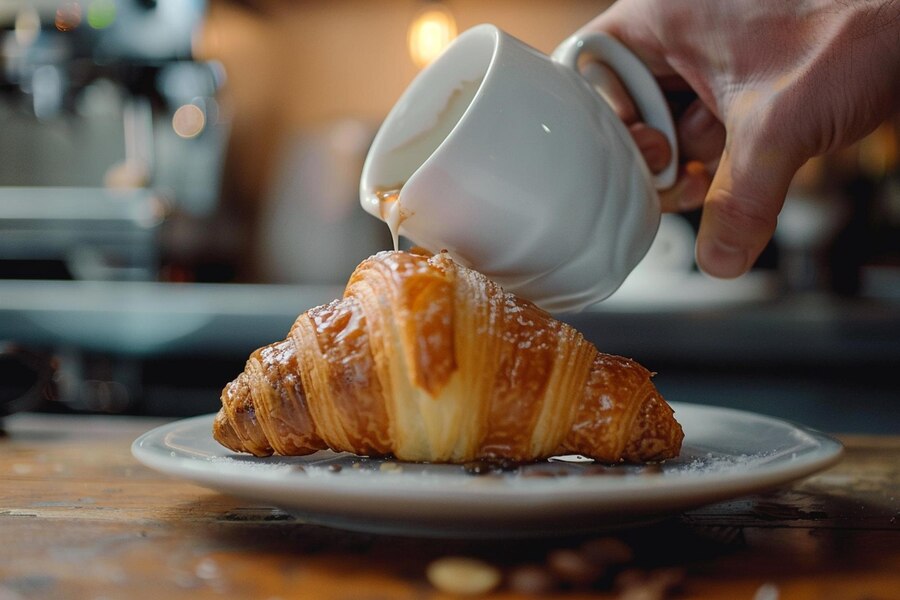Gipfeli, the Swiss variant of croissants, offer a delightful blend of buttery, flaky goodness that transcends borders. This guide will lead you through every step to create these delectable pastries, from preparing the dough to achieving the perfect golden crust. Whether you’re a baking novice or a seasoned chef, this comprehensive Gipfeli Recipe will help you master the art of Gipfeli.
Introduction to Gipfeli
Gipfeli, also known as Swiss croissants, are a beloved pastry in Switzerland. They are characterized by their delicate, flaky layers and buttery flavor, which make them a perfect treat for breakfast or a snack. The name “Gipfeli” is derived from the German word “Gipfel,” meaning peak, which refers to the crescent shape of the pastry.
Ingredients: What You Need
To make Gipfeli, you’ll need the following ingredients:
For the Dough
- 500 grams (4 cups) all-purpose flour
- 250 grams (1 cup) unsalted butter, chilled
- 200 ml (7 fl oz) whole milk
- 50 grams (1/4 cup) granulated sugar
- 10 grams (2 teaspoons) salt
- 20 grams (2 teaspoons) active dry yeast
- 1 large egg (for egg wash)
For the Butter Layer
- 250 grams (1 cup) unsalted butter, softened
Optional Filling
- 100 grams (1/2 cup) chocolate chips
- 100 grams (1/2 cup) almond paste
- Jam or preserves of your choice
Step 1: Preparing the Dough
Activate the Yeast: In a small bowl, combine 50 ml (1.7 fl oz) of warm milk with the sugar and yeast. Stir and let it sit for about 5 minutes until it becomes frothy.
Mix Dry Ingredients: In a large bowl, sift the flour and salt together.
Combine Wet and Dry Ingredients: Make a well in the center of the flour mixture and pour in the remaining milk, the activated yeast mixture, and the egg. Mix until a dough starts to form.
Knead the Dough: Turn the dough out onto a lightly floured surface and knead for about 10 minutes, or until it becomes smooth and elastic. You may need to add a bit more flour if the dough is too sticky.
Let the Dough Rise: Place the dough in a lightly greased bowl, cover it with plastic wrap or a damp cloth, and let it rise in a warm place for about 1 hour, or until it has doubled in size.
Step 2: Preparing the Butter Layer
Soften the Butter: While the dough is rising, prepare the butter layer. Place the softened butter between two sheets of parchment paper.
Roll the Butter: Using a rolling pin, flatten and shape the butter into a rectangle about 1/2 inch thick. Chill it in the refrigerator while the dough continues to rise.
Step 3: Laminating the Dough
Roll Out the Dough: Once the dough has risen, punch it down and turn it out onto a floured surface. Roll it out into a large rectangle about 1/4 inch thick.
Incorporate the Butter: Place the chilled butter rectangle in the center of the dough. Fold the dough over the butter, sealing the edges.
Roll and Fold: Roll the dough out into a large rectangle again. Fold it into thirds, like a letter, and refrigerate for 30 minutes. Repeat this rolling and folding process two more times, refrigerating between each fold.
Step 4: Shaping the Gipfeli
Preheat Oven: Preheat your oven to 375°F (190°C).
Cut the Dough: Roll the dough out into a large rectangle once more. Cut the dough into triangles, about 4-6 inches wide at the base.
Shape the Gipfeli: Starting from the base of each triangle, roll the dough up towards the tip, forming a crescent shape. Place the shaped gipfeli onto a baking sheet lined with parchment paper.
Apply Egg Wash: Beat the egg and brush it over the top of each gipfeli for a golden, glossy finish.
Step 5: Baking the Gipfeli
Bake: Place the baking sheet in the preheated oven and bake for 15-20 minutes, or until the gipfeli are golden brown and puffed up.
Cool: Remove from the oven and let them cool on a wire rack.
Tips for Perfect Gipfeli
Butter Temperature: Ensure the butter is properly chilled and firm for lamination. Soft butter will not create the desired flaky layers.
Dough Handling: Handle the dough as little as possible to avoid warming it up and compromising the flaky texture.
Chilling Time: Do not skip the chilling times between folds. This helps to maintain the structure of the layers.
Oven Temperature: Ensure your oven is preheated to the correct temperature for even baking.
Troubleshooting Common Issues
Dense Gipfeli: If your gipfeli are dense, it might be due to overworking the dough or not allowing it to rise properly. Ensure proper kneading and rising times.
Flat Gipfeli: If they don’t rise properly, check your yeast to ensure it’s active and that the dough is placed in a warm, draft-free area to rise.
Uneven Baking: Rotate the baking sheet halfway through baking for even results.
Serving Suggestions
Gipfeli are delicious on their own, but you can also serve them with:
Fresh fruit preserves or jam
A dusting of powdered sugar
A side of coffee or hot chocolate
Conclusion
Making gipfeli is a rewarding process that results in light, flaky, and buttery pastries perfect for any occasion. By following this guide, you’ll be able to master the art of creating these delectable treats. Enjoy the process, and savor the delicious results!







